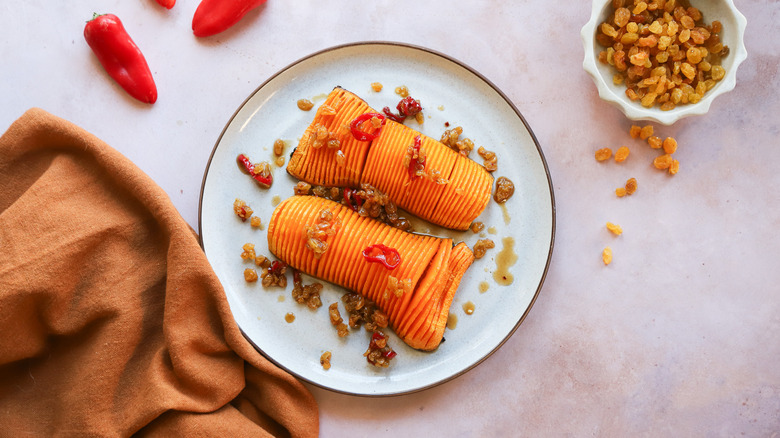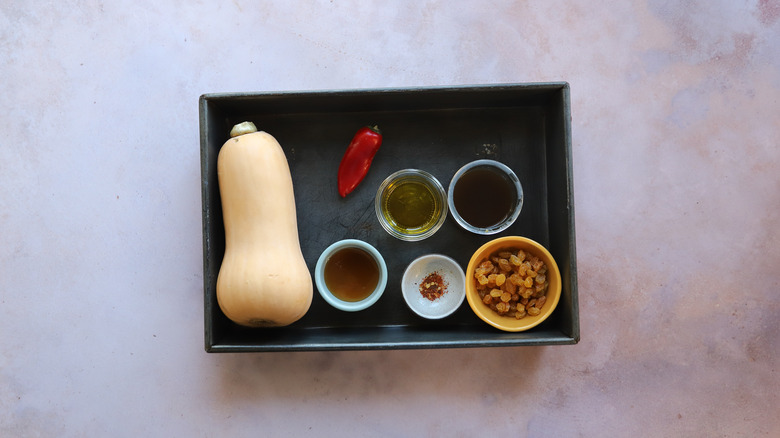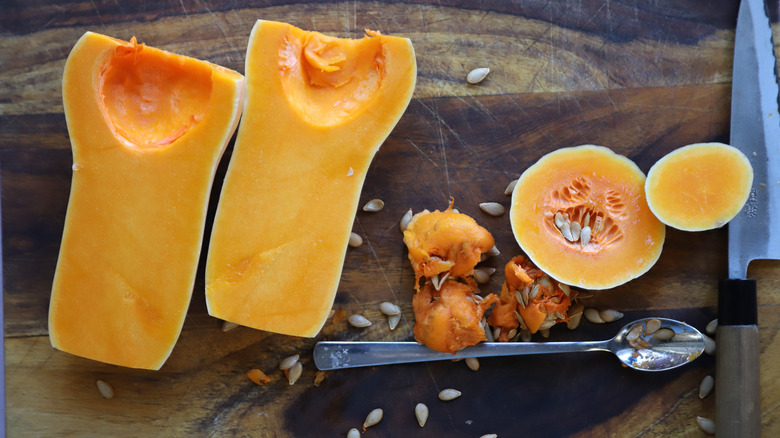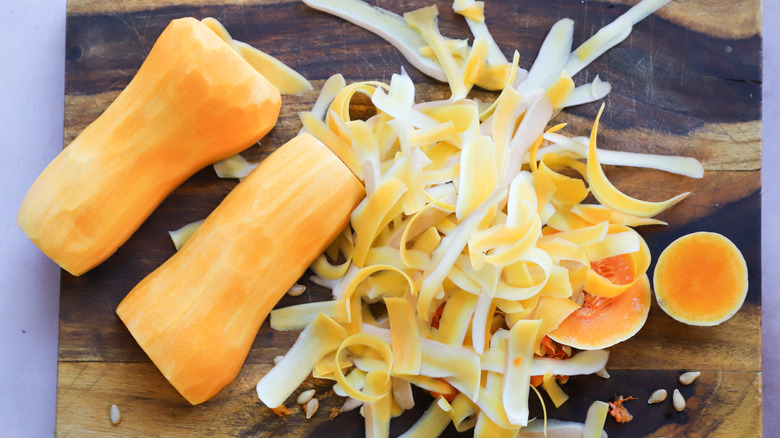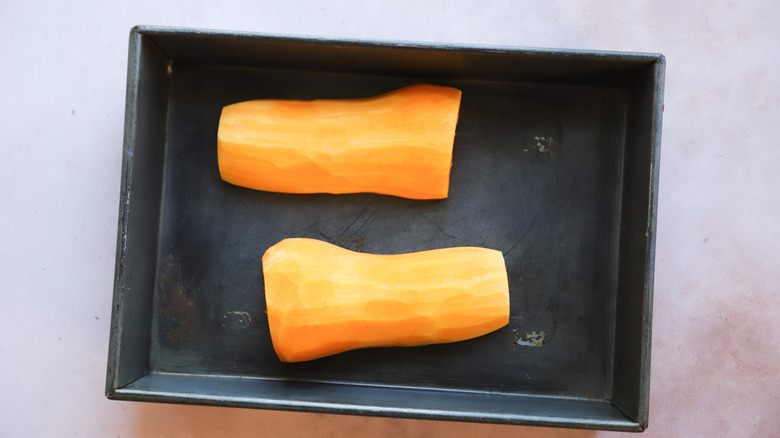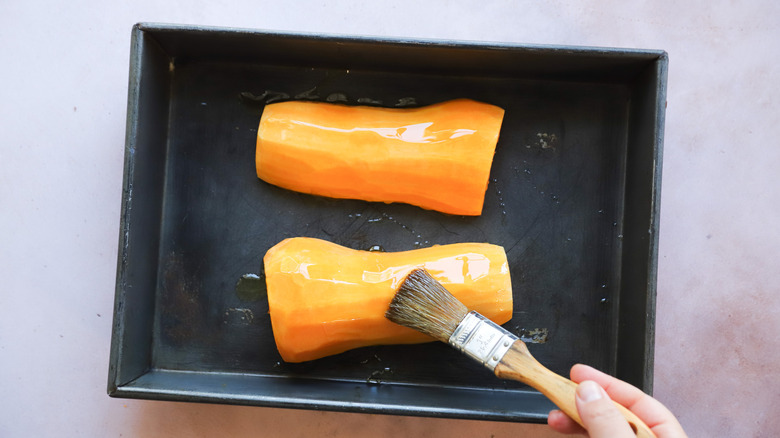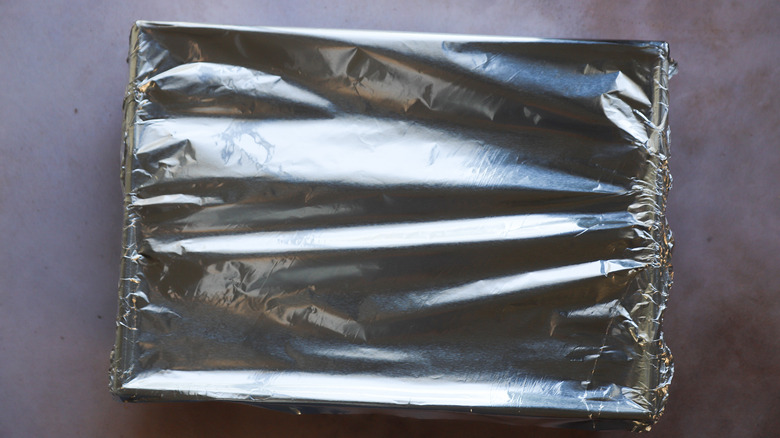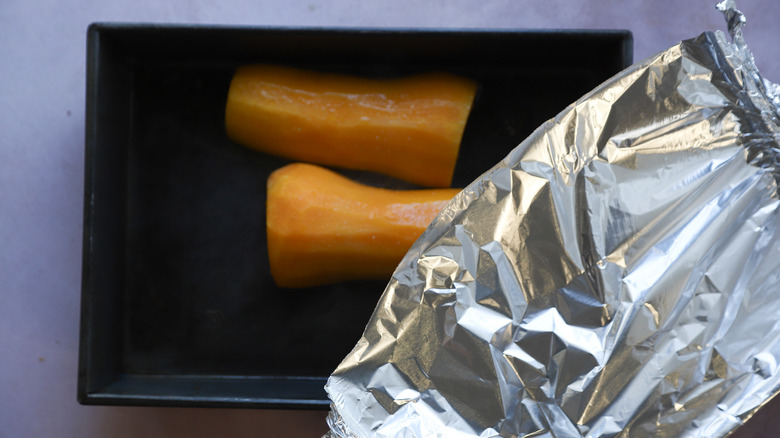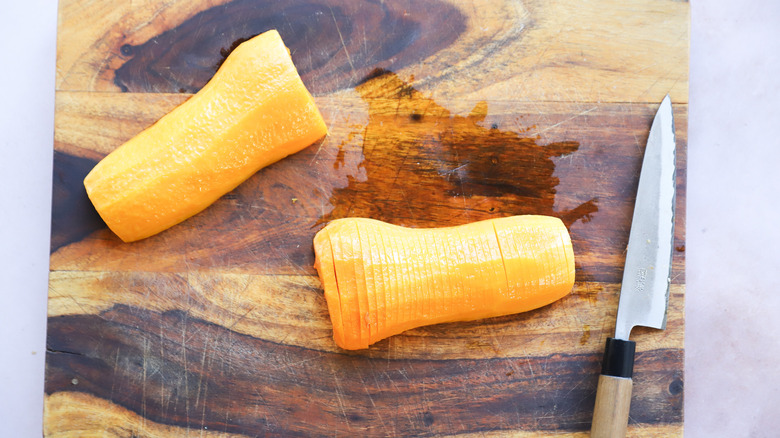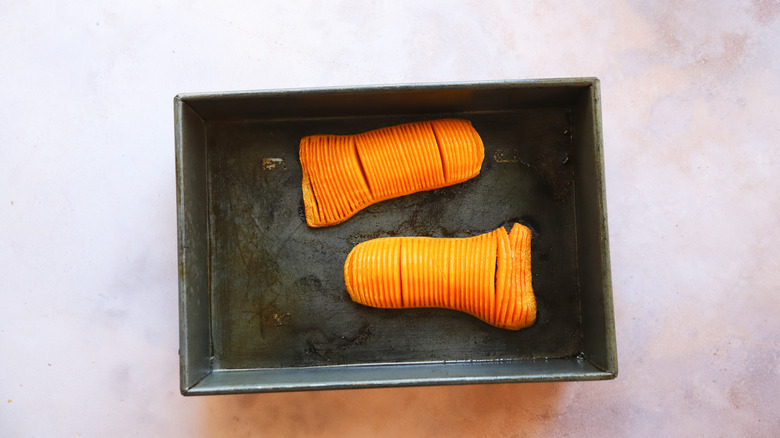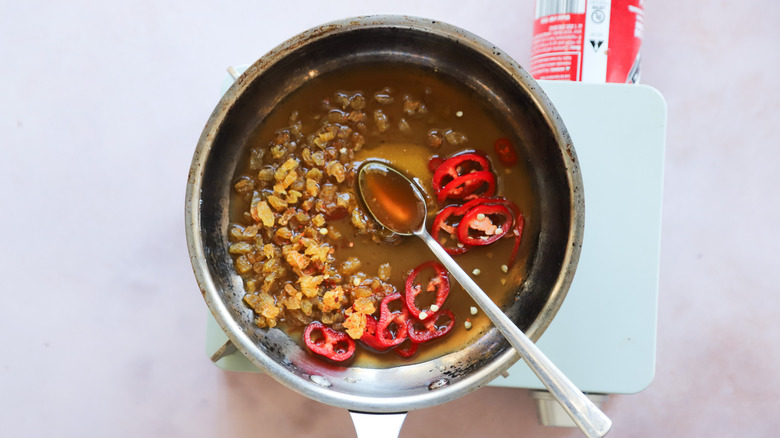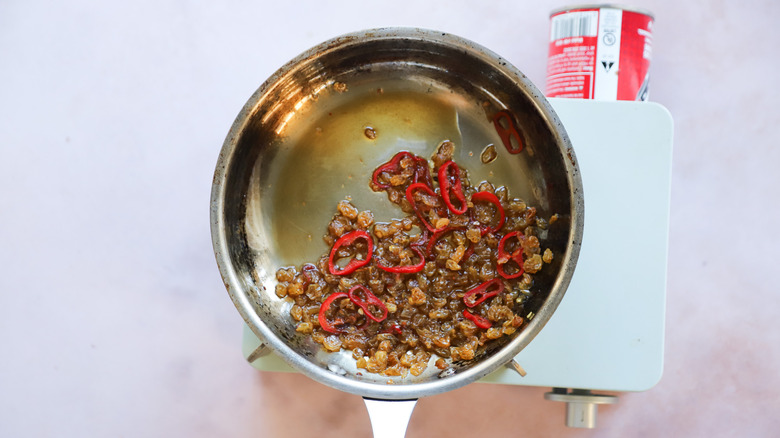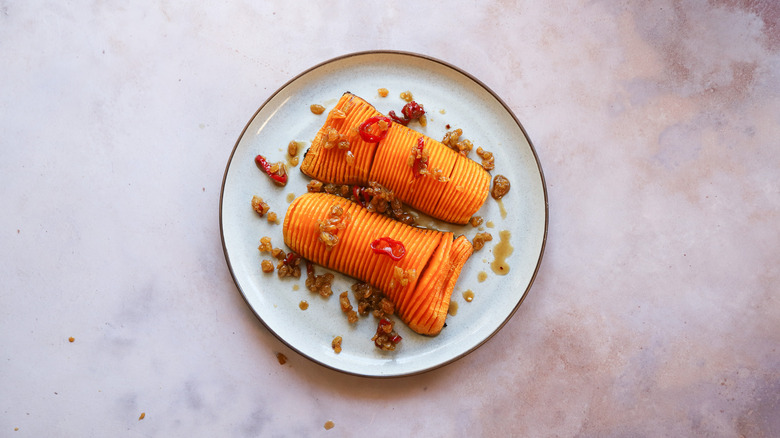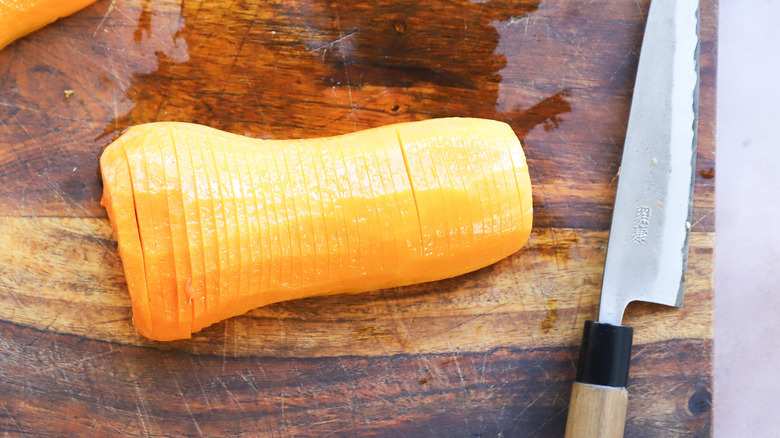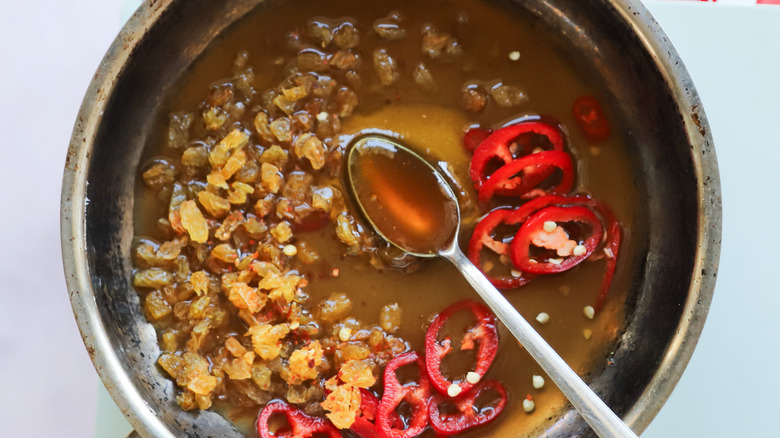Sweet And Spicy Hasselback Squash With Fresno Chile Agrodolce Recipe
Meat dishes get all the fanfare at dinner parties and fancy celebrations. Rack of lamb, beef wellington, roast chicken — these dishes beg to get the prime spot right in the middle of the dinner table. But, what about some vegetarian options? Hasselback squash is a decadent culinary creation that elevates the humble vegetable to star status. Hasselback squash is a delightful dish inspired by the famous Hasselback potatoes, a dish that originated in Sweden. The technique, where potatoes were sliced nearly through in thin segments, created a fan-like appearance that allowed for flavors to permeate more deeply during cooking.
When prepared as Hasselback squash, the deep cuts in the flesh of the squash not only allow for better absorption of seasonings and sauces but also create a striking presentation. In this recipe, developer Taylor Murray pairs the squash with a sweet and spicy agrodolce sauce that sounds fancy but is simple to make and comes together in a snap.
Gather the ingredients for Hasselback squash and Fresno chile agrodolce
The ingredients for the squash itself are simply butternut squash and olive oil. For this particular recipe, we are going to be making an agrodolce using honey, moscato (or white wine) vinegar, golden raisins, dried red pepper flakes, and a red Fresno chile. For extra heat, you can opt for a spicier pepper, like a red jalapeño or a serrano.
Step 1: Heat the oven
Preheat the oven to 425 F.
Step 2: Prepare the squash
Halve the squash and remove seeds.
Step 3: Peel the exterior
Peel the outside skin and any white membrane.
Step 4: Transfer to a pan
Place on a 9x13-inch baking pan.
Step 5: Brush with oil
Brush with olive oil.
Step 6: Cover with foil
Cover the pan tightly with aluminum foil.
Step 7: Roast the squash
Roast until the squash is just beginning to soften, about 20 minutes.
Step 8: Slice the squash
Remove the squash from the pan and transfer to a cutting board. Score the rounded sides crosswise, leaving ½ inch uncut at the bottom.
Step 9: Continue roasting squash
Return squash to the pan and return to the oven, uncovered.
Step 10: Roast until browned
Roast until the squash is browned and totally soft, about 30 more minutes.
Step 11: Make the sauce
Meanwhile, make the agrodolce: Add the chile, moscato or white wine vinegar, honey, raisins, red pepper flakes, and a pinch of salt to a small saucepan over medium heat.
Step 12: Simmer
Simmer until syrupy, about 5 minutes.
Step 13: Serve
Transfer squash to a plate and drizzle with agrodolce to serve.
How do I slice the butternut squash Hasselback-style without cutting all the way through?
Slicing a butternut squash without cutting all the way through is a key step in this recipe to achieve perfect texture and presentation. Using two chopsticks or wooden spoons placed on either side of the squash as a guide is an effective technique to ensure even and partial slicing without slicing all the way through. Once the squash has par-baked, this technique is far easier than trying to attempt it when the squash is raw.
After the initial roasting and peeling of the squash, place it on a cutting board. Position a chopstick or wooden spoon on either side of the squash, running perpendicular to where you will be making your cuts. Using a sharp knife, start slicing the squash crosswise at regular intervals, aiming for about ¼- to ⅛-inch slices. As you cut down, the chopsticks or wooden spoons will prevent the knife from going all the way through, leaving about 1/4-inch uncut at the bottom. This technique ensures that the squash remains intact while allowing the slices to open up slightly during the final roasting.
What can I use as a substitute for moscato in the agrodolce if I don't have it on hand?
Moscato, a sweet and aromatic wine, plays a significant role in the flavor profile of the agrodolce for this recipe. Moscato vinegar can be a fun and unique ingredient to use if you can find it. However, if moscato vinegar is not available, you can use several substitutes without compromising the dish's balance of sweetness and acidity. White balsamic vinegar has a similarly sweet and mild flavor profile to moscato vinegar. It's excellent for dressings, marinades, or to drizzle over roasted vegetables. Apple cider vinegar, with its fruity undertones, can be a good substitute. If you find it too tart, you can balance it with a bit of honey or sugar to mimic the sweetness of moscato vinegar. Remember — the key to a good agrodolce is the balance of sweetness and acidity. Whichever substitute you choose, adjust the sweetness and tartness to your taste, ensuring it complements the natural flavor of the butternut squash.
Sweet and Spicy Hasselback Squash With Fresno Chile Agrodolce Recipe
Butternut squash is always delicious, but this recipe levels the gourd up with a sweet-spicy agrodolce and a visually stunning Hasselback presenation.
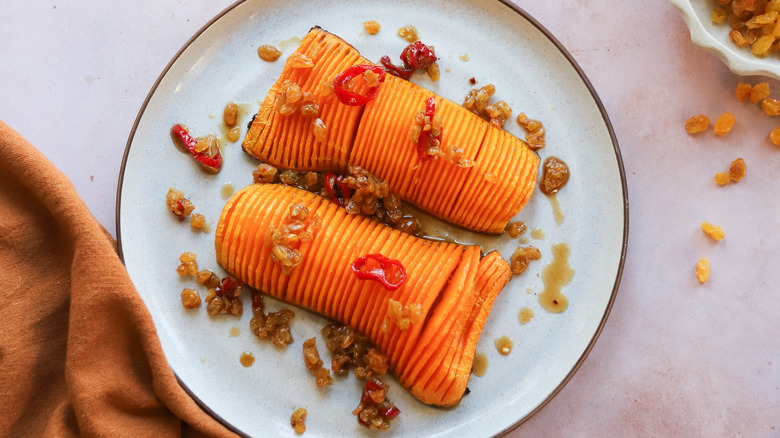
Ingredients
- 1 butternut squash, about 10 ounces
- 1 tablespoon olive oil
- 1 Fresno chile, thinly sliced
- ½ cup moscato or white wine vinegar
- 1 ½ tablespoons honey
- 2 tablespoons golden raisins, chopped
- ¼ teaspoon crushed red pepper flakes
- Salt, to taste
Directions
- Preheat the oven to 425 F.
- Halve the squash and remove seeds.
- Peel the outside skin and any white membrane.
- Place on a 9x13-inch baking pan.
- Brush with olive oil.
- Cover the pan tightly with aluminum foil.
- Roast until the squash is just beginning to soften, about 20 minutes.
- Remove the squash from the pan and transfer to a cutting board. Score the rounded sides crosswise, leaving ½ inch uncut at the bottom.
- Return squash to the pan and return to the oven, uncovered.
- Roast until the squash is browned and totally soft, about 30 more minutes.
- Meanwhile, make the agrodolce: Add the chile, moscato or white wine vinegar, honey, raisins, red pepper flakes, and a pinch of salt to a small saucepan over medium heat.
- Simmer until syrupy, about 5 minutes.
- Transfer squash to a plate and drizzle with agrodolce to serve.
Nutrition
| Calories per Serving | 104 |
| Total Fat | 3.5 g |
| Saturated Fat | 0.5 g |
| Trans Fat | 0.0 g |
| Cholesterol | 0.0 mg |
| Total Carbohydrates | 18.1 g |
| Dietary Fiber | 1.5 g |
| Total Sugars | 11.4 g |
| Sodium | 297.0 mg |
| Protein | 1.0 g |
